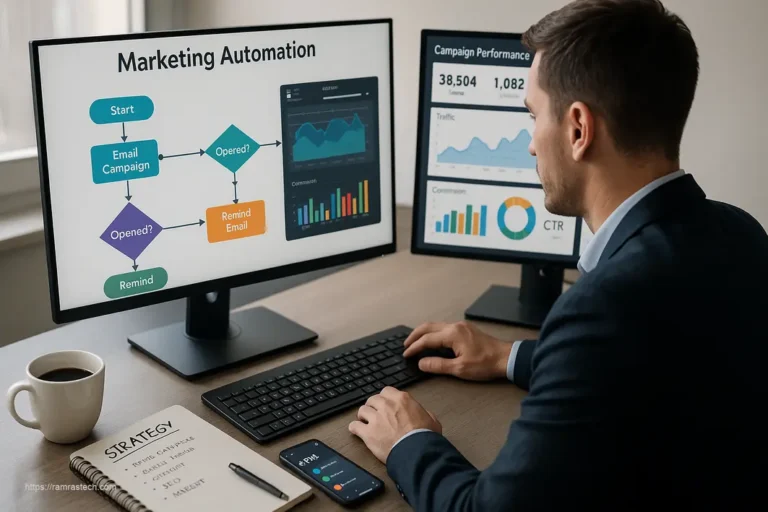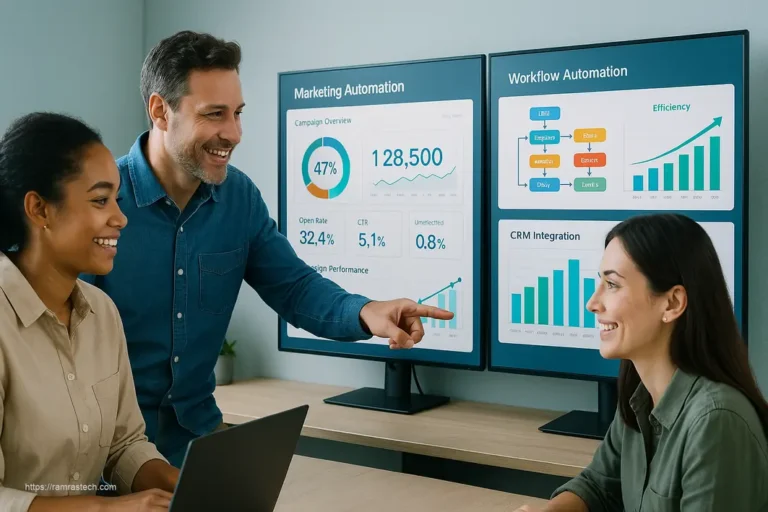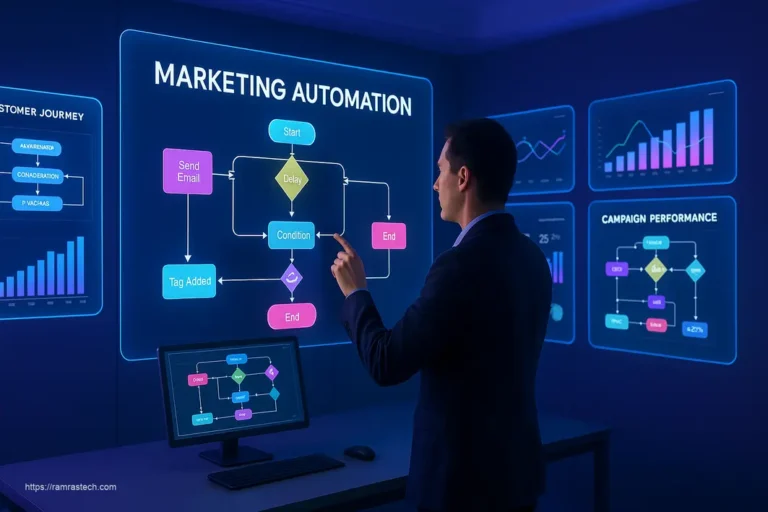5 Unstoppable Marketing Automation Tips for Seamless Workflows
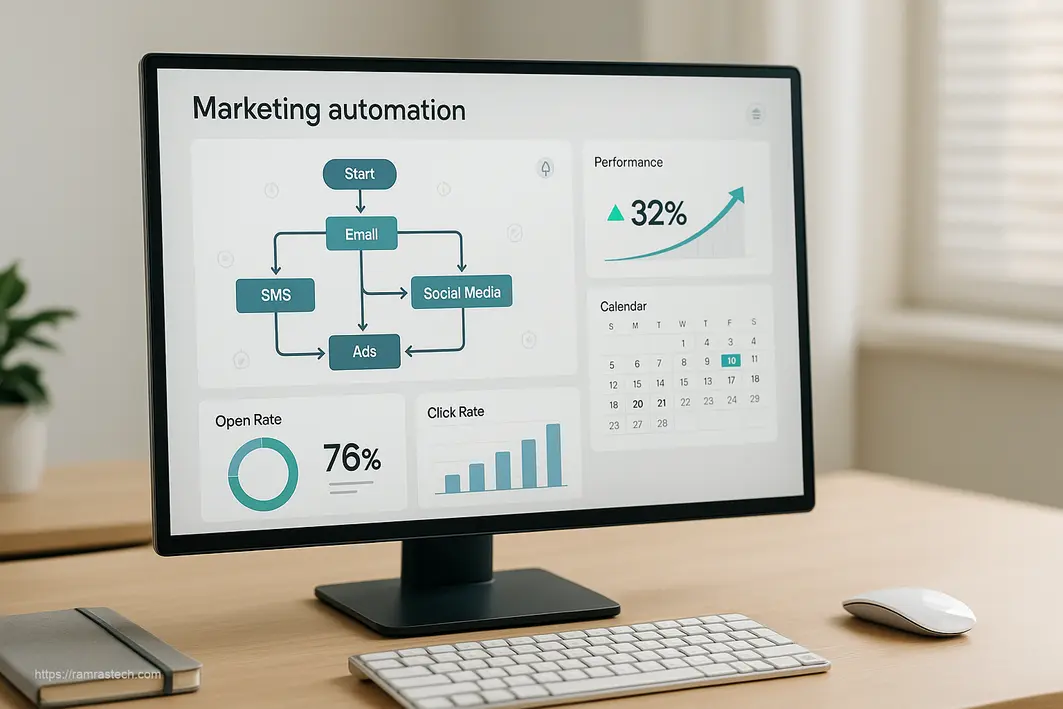
Ever felt like there just aren’t enough hours in the day to handle all your marketing tasks? You’re definitely not alone. As marketing demands grow more complex, it’s becoming nearly impossible to manage everything manually—from email campaigns to social media posts to lead nurturing. That’s where marketing automation steps in as your digital marketing superhero!
Marketing automation has revolutionized how businesses connect with their audiences. But here’s the truth: simply having automation tools isn’t enough. You need to know how to use them effectively. I’ve spent years implementing these systems for businesses of all sizes, and I’m here to share the marketing automation tips that actually deliver results.
What Is Marketing Automation and Why Does It Matter?
Before diving into specific tips, let’s get clear on what we’re talking about. Marketing automation refers to technology platforms and software that help marketers streamline repetitive tasks and workflows. Think of it as your marketing department’s efficiency engine—it handles the routine stuff so your team can focus on strategy and creativity.
The impact? Companies using marketing automation report up to 77% higher conversion rates. Pretty impressive, right?
But marketing automation isn’t just about efficiency. It’s about creating better experiences for your customers through:
- Personalized, timely communications
- Consistent messaging across channels
- Better lead nurturing and qualification
- Data-driven decision making
- Scalable marketing processes
Let’s explore the marketing automation tips that can transform your business results.
1. Start With a Clear Strategy, Not Just Tools
One of the biggest mistakes I see? Companies rushing to implement marketing automation tools without first developing a clear strategy. It’s like buying an expensive sports car without knowing how to drive—impressive but ultimately useless.
Before selecting any automated marketing solutions, ask yourself:
- What specific problems am I trying to solve?
- Which marketing processes take up the most time?
- What key metrics do I want to improve?
- How will automation integrate with our existing workflows?
- Do we have the skills and resources to manage these tools?
Develop a roadmap that outlines how automation will support your broader marketing goals. This strategic foundation will guide your tool selection and implementation process.
2. Choose the Right Marketing Automation Platform for YOUR Business
The marketing automation landscape is crowded—from comprehensive platforms like HubSpot, Marketo, and Salesforce Marketing Cloud to specialized tools for specific channels. Don’t make the mistake of choosing based solely on popularity or price.
Consider these factors when evaluating marketing automation platforms:
- Scalability: Will the platform grow with your business?
- Ease of use: Can your team navigate it without extensive training?
- Integration capabilities: Does it connect with your CRM, website, and other tools?
- Analytics and reporting: Does it provide the insights you need?
- Budget fit: Does the total cost of ownership (including implementation and maintenance) align with your resources?
- Support and training: What help is available when problems arise?
Remember, the “best” platform is the one that best serves your specific needs and constraints—not necessarily the one with the most features.
3. Master Customer Segmentation for Personalized Experiences
Segmentation is where marketing automation really shines. Instead of sending generic messages to everyone, you can deliver tailored content based on specific characteristics and behaviors.
Effective segmentation approaches include:
- Demographic segmentation: Age, location, company size, job title
- Behavioral segmentation: Website activity, content downloads, purchase history
- Engagement level: Active, dormant, prospect, customer
- Customer journey stage: Awareness, consideration, decision, retention
- Lead scoring: High-value prospects vs. early-stage leads
For example, a marketing automation system can automatically tag contacts who visit your pricing page three times as “high-intent leads” and trigger a personalized follow-up sequence.
Pro tip: Start with 3-5 key segments rather than trying to create dozens immediately. You can refine and expand as you gather more data.
4. Create Strategic Workflow Automations That Actually Make Sense
The heart of marketing automation is workflow design—the “if this, then that” logic that determines what happens when a contact takes specific actions.
Effective workflows might include:
- Welcome sequences for new subscribers or customers
- Lead nurturing pathways based on content interests
- Re-engagement campaigns for dormant contacts
- Upsell sequences for existing customers
- Renewal reminders for subscription-based businesses
The key is making these workflows feel natural, not robotic. Each step should logically follow from the previous one and provide real value to the recipient.
“Too often, marketers design overly complex automation workflows that even they can’t fully understand,” explains marketing automation consultant Lisa Sparks. “Simplicity and clarity almost always outperform complexity and confusion.”
5. Leverage Dynamic Content for True Personalization
Basic personalization (“Hi [First Name]”) is now table stakes. Advanced marketing automation tips focus on dynamic content—elements that change based on who’s viewing them.
Dynamic content applications include:
- Email content that changes based on industry, role, or previous interactions
- Website elements that display different offers to different visitor segments
- CTAs that adapt based on where someone is in their buyer journey
- Form fields that change based on what you already know about a contact
This level of personalization creates experiences that feel tailored to each individual without requiring manual customization. Our recent guide on enhancing user experience through website design shares more insights on creating personalized digital experiences.
6. Build Automated Email Sequences That Convert
Email remains the cornerstone of most marketing automation strategies—and for good reason. It’s direct, personal, and highly measurable.
High-performing automated email sequences typically include:
- Abandoned cart recovery: Automatically remind shoppers about items they left behind
- Post-purchase follow-ups: Delivery updates, usage tips, and cross-sell opportunities
- Educational drip campaigns: Gradually introducing prospects to your solutions
- Event follow-up: Automated touchpoints after webinars, trade shows, or downloads
- Milestone celebrations: Birthday emails, anniversary messages, or usage achievements
“The key to effective email automation isn’t just sending messages—it’s creating conversation opportunities,” says email marketing strategist David Chen. “Each email should invite engagement, not just deliver information.”
For inspiration, check out our comprehensive guide to email marketing tools for small businesses.
7. Implement Lead Scoring to Focus on High-Value Prospects
Not all leads deserve equal attention. Lead scoring helps prioritize your follow-up efforts by assigning point values to specific actions and attributes.
A basic lead scoring model might award points for:
- Demographic fit: How well the prospect matches your ideal customer profile
- Engagement behaviors: Email opens, clicks, website visits, content downloads
- High-intent actions: Pricing page visits, demo requests, sales inquiries
- Recency and frequency: How recently and how often they’ve engaged
When a lead reaches a predetermined score threshold, your marketing automation platform can automatically route them to sales or trigger high-touch nurturing sequences.
Remember to regularly review and refine your scoring model based on which leads actually convert to customers.
8. Connect Your CRM and Marketing Automation for a Unified View
Marketing automation shouldn’t exist in isolation. Integration with your CRM creates a powerful ecosystem where marketing and sales data flow seamlessly.
Benefits of tight CRM-marketing automation integration include:
- Closed-loop reporting that shows which marketing efforts drive actual revenue
- 360-degree customer views that capture all touchpoints and interactions
- Sales insights that help reps have more relevant conversations
- Smoother lead handoffs between marketing and sales
As one CMO told me, “The day we fully integrated our marketing automation and CRM was the day our marketing department finally started speaking the same language as our sales team.”
9. Set Up Automated Performance Reporting and Dashboards
One of the most valuable but underutilized marketing automation tips is leveraging automated reporting. Why spend hours compiling data manually when your system can do it for you?
Consider setting up:
- Weekly performance snapshots delivered automatically to stakeholders
- Real-time dashboards showing KPIs like conversion rates and engagement metrics
- Campaign comparison reports that highlight what’s working and what isn’t
- ROI calculations that connect marketing activities to revenue
Automated reporting not only saves time but also encourages data-driven decision-making across your organization. For insights on tracking digital marketing performance, explore our introduction to Google Analytics.
10. Use Behavioral Triggers for Timely Follow-Up
The right message at the right time can make all the difference. Behavioral triggers initiate specific actions based on how contacts interact with your content.
Powerful trigger examples include:
- Website revisits: If someone returns to your site multiple times in a week
- High-intent page views: When someone visits your pricing, comparison, or case study pages
- Content consumption patterns: If someone reads multiple blog posts on a specific topic
- Cart and form abandonment: When someone starts but doesn’t complete a conversion action
These triggers can activate targeted emails, notifications to sales, or even dynamic website content changes—all delivered at the perfect moment when interest is highest.
11. Leverage Social Media Automation (Without Looking Robotic)
Social media management can devour time. Automation helps reclaim those hours while maintaining an authentic presence.
Effective social media automation strategies include:
- Content scheduling across platforms from a central calendar
- Automated content curation that shares industry news and insights
- Cross-posting adapted for each platform’s unique format and audience
- Performance monitoring that flags posts needing human response
- Hashtag research and optimization
The key is using automation for the mechanical aspects while preserving your brand’s authentic voice. As our guide to social media marketing tips explains, balance is crucial.
“Automate the routine, humanize the exceptional,” advises social media consultant Maria Rodriguez. “Let automation handle scheduling and metrics, but keep your unique voice and community engagement decidedly human.”
12. Create Multi-Channel Automation Journeys
Most customer journeys span multiple channels—email, social, website, SMS, and more. Advanced marketing automation tips focus on orchestrating these touchpoints into cohesive experiences.
Multi-channel journeys might include:
- An automated webinar registration email that triggers a calendar invite and reminder SMS
- A download that initiates an email sequence, retargeting ads, and personalized website content
- A purchase that triggers transactional emails, delivery notifications, and a post-purchase survey
The goal is creating a consistent experience regardless of where and how customers interact with your brand. Our comprehensive digital marketing strategies guide provides more insights on this approach.
13. Implement Progressive Profiling to Build Contact Data Over Time
Asking for too much information upfront creates friction. Progressive profiling solves this by gradually collecting data points across multiple interactions.
For example:
- First conversion: Collect only email address and name
- Second conversion: Ask for company and role
- Third conversion: Request industry and team size
Your marketing automation platform can dynamically change form fields based on what you already know, making each interaction feel personalized while steadily building a comprehensive profile.
This approach typically increases conversion rates while ultimately gathering more useful data than trying to collect everything at once.
14. Develop a Testing and Optimization Framework
Automation doesn’t mean “set it and forget it.” The most successful programs incorporate systematic testing and optimization.
Elements worth testing include:
- Email subject lines, preheaders, and send times
- Call-to-action wording, design, and placement
- Landing page layouts and form structures
- Content offers and downloads
- Automation workflow timing and sequences
Implement A/B testing capabilities within your marketing automation platform, and establish a regular cadence for reviewing results and applying insights. Small improvements compound over time into significant performance gains.
For conversion optimization techniques, check out our guide to conversion rate optimization basics.
15. Focus on Marketing Automation Governance and Maintenance
As your marketing automation ecosystem grows more complex, governance becomes increasingly important. Without proper maintenance, even the best system will eventually break down.
Establish clear protocols for:
- Data hygiene: Regular cleansing and standardization of contact records
- Content audits: Reviewing and updating automated content for relevance
- Workflow reviews: Evaluating the performance of automation sequences
- Permission management: Controlling who can create or modify automations
- Documentation: Maintaining clear records of system structure and logic
“We dedicate the first Monday of every month to marketing automation maintenance,” shares marketing operations director Sam Wilson. “It’s like changing the oil in your car—not glamorous, but skipping it guarantees problems down the road.”
The Future of Marketing Automation: AI and Predictive Capabilities
As we look ahead, marketing automation is evolving beyond rule-based workflows toward truly intelligent systems. The integration of artificial intelligence and machine learning is creating new possibilities:
- Predictive lead scoring that identifies likely buyers before they self-identify
- Content recommendations powered by natural language processing
- Send-time optimization that delivers messages when recipients are most likely to engage
- Automated segment discovery that identifies patterns humans might miss
- Conversational marketing through increasingly sophisticated chatbots
Stay ahead of these trends by exploring our guide to building chatbots for lead generation and revolutionary marketing automation hacks.
Common Marketing Automation Mistakes to Avoid
As we wrap up these marketing automation tips, let’s address some common pitfalls:
- Over-automation: Trying to automate everything, including elements that benefit from human touch
- Neglecting the customer perspective: Creating workflows that serve your needs but ignore user experience
- Poor segmentation: Relying on basic demographic data rather than meaningful behavioral signals
- Forgetting to test: Assuming automations will perform optimally without regular testing
- Siloed implementation: Treating marketing automation as separate from your broader marketing strategy
By avoiding these mistakes and implementing the marketing automation tips above, you’ll create systems that genuinely enhance both efficiency and effectiveness.
FAQ About Marketing Automation Tips
How much does marketing automation software typically cost?
Marketing automation pricing varies widely based on features and company size. Entry-level solutions start around $200-300/month, mid-market platforms range from $800-1,500/month, and enterprise solutions can cost $3,000+/month. Many providers charge based on contact database size or email volume. For budget-conscious businesses, check our guide to affordable marketing automation for SMEs.
How long does it take to implement a marketing automation platform?
Implementation timelines typically range from 1-3 months for basic setups to 3-6 months for complex enterprise deployments. The process includes installation, integration with existing systems, data migration, workflow creation, template design, team training, and testing. Starting with a focused pilot project often provides quicker wins while building toward comprehensive implementation.
What skills does my team need to manage marketing automation effectively?
Successful marketing automation requires a mix of strategic and technical skills: marketing strategy, customer journey mapping, content creation, basic HTML/CSS knowledge, data analysis, and technical problem-solving abilities. Many teams combine specialists (like email marketers or analytics experts) with marketing generalists who understand the big picture. Ongoing training is essential as platforms continuously evolve.
Can small businesses benefit from marketing automation?
Absolutely! Small businesses often see the most dramatic benefits from marketing automation as it multiplies their limited resources. Start with core functionalities like email automation and lead nurturing before expanding to more sophisticated applications. Many platforms offer scaled pricing or specific small business packages. Our digital marketing for small business guide provides additional insights.
How do I measure the ROI of marketing automation?
Key metrics for evaluating marketing automation ROI include: time saved on routine tasks, lead generation volume and quality improvements, conversion rate increases, customer retention rates, campaign performance metrics, and ultimate revenue impact. Compare pre-automation benchmarks with post-implementation results, and continue tracking these metrics quarterly to demonstrate ongoing value.
Taking Your Next Steps With Marketing Automation
Whether you’re just beginning your automation journey or looking to optimize an existing system, these marketing automation tips provide a roadmap for success. The key is to start where you are, focus on solving real business problems, and build complexity gradually as you learn what works for your specific audience.
Remember that marketing automation is a tool for enhancing human connections, not replacing them. The most successful programs combine technological efficiency with authentic, personal engagement.
Which of these marketing automation tips will you implement first? Share your experiences or questions in the comments—I’d love to continue the conversation!
